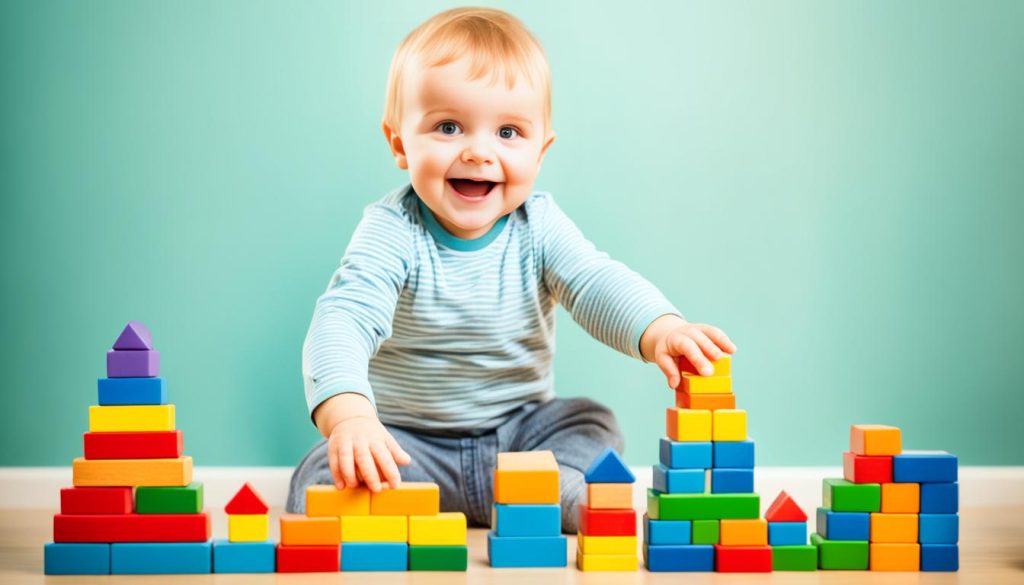Imagine your child’s eyes welling up with tears after a tough day at school. Maybe they got picked on, didn’t do well on a test, or felt left out. As a parent, it hurts to see them suffer. But, building resilience in your kids isn’t about keeping them from pain. It’s about teaching them how to handle life’s ups and downs.
Resilience is the amazing skill kids have to bounce back from tough times. This includes adapting to new situations, standing up to bullies, or dealing with family problems. It’s not something they’re born with, but it can be learned.
Even though kids seem carefree, they face their own emotional struggles and doubts. They need resilience to get through these tough times. By using positive parenting, encouraging independence, and boosting their self-esteem, you can help them overcome their challenges.
Resilience is more than just bouncing back. It’s about keeping a positive outlook and growing stronger despite the hard times. This article will share tips and strategies to help your child become more resilient. It will show how it can reduce stress and anxiety and build their confidence for life.
Your role in teaching your child resilience is crucial. Make sure they know they have your support when they face tough times. This support is key to helping them grow strong and confident.
Key Takeaways
- Understanding resilience as the ability to thrive despite adversities.
- Strategies for fostering resilience in children at different developmental stages, from preschool to high school.
- The role of a supportive environment in building resilience, including family, community, and school support.
- The importance of nurturing a positive self-view and a hopeful outlook in children.
- Practical tips for positive parenting, including establishing daily routines and fostering child independence.
The Importance of Resilience in Child Development
Resilience is key for kids to thrive, even when life gets tough. This includes things like divorce or living in hard areas. Knowing what resilience is and how it helps kids grow can help parents and caregivers support it. This part will look at what makes resilience and how it shapes kids’ growth.
Understanding Resilience
Resilience is about how kids handle hard times, not just avoiding them. Kids who bounce back well often have a strong biology and good relationships with adults. These relationships are vital, as they show how people connect in their world, based on Urie Bronfenbrenner’s model.
Helping kids feel capable, building strong adult-child bonds, and giving them chances to learn new skills are key to resilience. These steps help kids grow strong.

The Impact of Resilience on Child Development
Resilience is crucial for kids’ mental health and leads to good outcomes. Kids who are resilient don’t shy away from problems or handle them badly. They tend to be healthier, both physically and mentally, than kids who aren’t as resilient.
Encouraging kids to be creative helps them deal with challenges better. The skills that make resilience possible, like coping with problems and having strong adult support, can grow at any age. Celebrating good times and teaching kids how to solve problems also boosts resilience.
“Learning to cope with manageable threats is critical for the development of resilience.”
Building resilience takes time and shows kids how adults handle tough times. Teaching kids to be kind to themselves and to keep trying after a setback can really help. The support from family, teachers, and friends is key in making kids feel safe and confident, which helps them grow resilient.
| Factors Influencing Resilience | Importance |
|---|---|
| Supportive Adult-Child Relationships | Essential for social and emotional adjustment |
| Opportunities to Strengthen Adaptive Skills | Critical for facing adversity and emerging stronger |
| Encouraging Child Creativity | Allows expression and better handling of setbacks |
| Supporting Child Mental Health | Linked with better physical and mental health outcomes |
Building a Supportive Environment
Creating a supportive environment is key for kids to be resilient. It’s all about the family and the community working together. Kids need to feel safe and loved.
The Role of Family
The family is the base for teaching kids good discipline and building a strong bond. Kids who eat dinner with their families behave better and do well in school. Showing love with hugs and kisses makes the home a positive place.
Parents play a big part. Spending time together daily keeps families close and stops kids from feeling left out. Talking well in the family means stronger ties and handling tough feelings better. Praising kids helps boost their confidence.

A stable family life is key. Having set routines and rituals makes kids feel secure. This is very important during hard times or big changes. Setting family values and rules guides kids through life’s ups and downs.
Community and School Support
Support from the community and school is also vital. Teachers, friends, and neighbors help kids a lot. Feeling close to family, friends, and the neighborhood helps kids know who they are and where they fit in. Joining in community activities boosts their self-esteem and teaches them about different cultures.
It’s important to teach kids about diversity in a caring community. Seeing different views helps kids understand and be more empathetic. Schools can do this with inclusive lessons and programs that celebrate all cultures.
To sum up, a strong support system of family, school, and community is key for raising resilient kids. This network gives kids the care, structure, and support they need to do well.
Encouraging Positive Relationships
Building strong relationships is key to helping kids bounce back from tough times. It starts at home and grows with friends and trusted adults outside. By working on *parent-child communication*, *teaching kids responsibility*, and *fostering child independence*, you make a supportive space for your child to grow emotionally and socially.

Making Connections with Peers
Helping your child make friends is vital for their social growth. These friendships offer emotional support, improve social skills, and teach empathy. Kids learn to handle social situations, share stories, and solve problems together. Spending quality time with them helps build these strong friendships and understand each other better.
- Interacting with children in their first three years aids in language development.
- Regular one-on-one time significantly impacts the quality of *parent-child communication*.
- Expressing love and saying “I love you” regularly can positively affect the long-term relationship.
The Role of Trusted Adults
Trusted adults like teachers, mentors, and coaches are crucial in a child’s life. They offer extra support and protection. These adults help kids manage their feelings and behaviors. Trusting these adults early on gives kids a sense of safety and confidence to explore the world.
- Experts are concerned about how distracted parenting can impact emotional bonding and social interaction.
- 6 out of 10 children in the U.S. develop secure attachments, indicating room for improvement in fostering secure bonds.
- Positive engagement aids in teaching necessary coping mechanisms and behavioral regulation skills.
Building positive relationships with friends and trusted adults greatly helps your child deal with challenges. By focusing on *parent-child communication* and *teaching kids responsibility*, you help your child become a well-rounded, independent person.
Fostering Emotional Intelligence in Children
Emotional intelligence is key to being resilient. It means understanding and managing your feelings and getting others’ emotions. Kids with high emotional smarts handle stress better and get others’ feelings. Learning about emotions helps them deal with stress and get along with friends.

Recognizing and Managing Emotions
It’s important to teach kids about emotions early. The first five years are key for learning about feelings. Using positive reinforcement parenting helps kids know their feelings and control them.
Helping kids manage their feelings is good for their mental health. Teaching them about emotions through play makes them more emotionally smart and resilient.
Empathy and Understanding in Children
Teaching kids to be empathetic is crucial. Doing activities that help them understand others makes them kinder and more connected. Kids with good emotional smarts talk better and solve problems with friends and adults.
Being emotionally smart helps kids do well in school and life. Parents showing good emotional skills and encouraging kids to share feelings are key. Emotionally smart kids bounce back from tough times better, which helps their self-esteem and mental health.
| Aspect | Benefit |
|---|---|
| Emotional Awareness | Improved self-identity and informed decision-making |
| Emotion Regulation | Better stress and anxiety management |
| Empathy Training | Enhanced kindness, compassion, and community building |
| Positive Reinforcement | Increased self-esteem and mental health |
In conclusion, teaching kids about emotions, managing feelings, and being empathetic is vital. Positive parenting, boosting self-esteem, and supporting mental health are key to raising emotionally strong kids.
Establishing Routine and Structure
A well-established routine and structure are key for your child’s growth. A daily routine balances various activities, making kids feel secure and confident. This helps them navigate their day smoothly.
The Benefits of a Daily Routine
Routine activities make children and teens feel safe and cared for. This stability is crucial during big changes like puberty or family events. Fun family routines also strengthen bonds and make kids feel they belong.
By managing screen time and setting clear boundaries, you create a predictable world. This helps boost their creativity and overall wellbeing.
- Children’s Benefits: Routine activities give kids a sense of safety and security.
- Skill Development: Getting kids involved in chores teaches them important skills like time management and responsibility.
- Health Impact: Routines encourage healthy habits, lower stress, and strengthen immune systems.
Balancing Flexibility and Consistency
Consistency is crucial for a routine, but flexibility is just as important. A too-rigid schedule can cause frustration when things don’t go as planned. Teaching kids to adapt to changes helps them become more resilient.
If a surprise visit from relatives changes your usual plan, help your child adjust gracefully. Still, remember to stress the need for setting boundaries with kids.
Following routines consistently can reduce stress for parents and improve decision-making. It also gives kids a sense of control, making them feel safe and building trust in their environment.
- Parental Benefits: Routines make parents feel organized and in control.
- Age-Specific Routines: Tailoring routines to different ages ensures they match kids’ developmental stages.
By encouraging creativity within a structured yet flexible routine, you equip your child to face life’s uncertainties with confidence and poise.
Promoting Self-Care and Healthy Habits
Teaching kids about self-care and healthy habits is key for their well-being and resilience. By starting early, you give them the tools to handle life’s ups and downs with confidence.
Essential Self-C care Practices
Self-care for your kids is more than just eating right and staying active. It also means enjoying free time and getting enough rest. These habits help keep their minds and hearts healthy, making it easier to deal with stress and stay strong.
- Nutritional Diet: Make sure your child eats a mix of fruits, veggies, and whole grains, as the 2020–2025 Dietary Guidelines suggest. This supports their growth and health, lowering the risk of diseases.
- Daily Exercise: Add regular physical activity to your child’s day. It keeps them at a healthy weight and lifts their mood.
- Leisure Activities: Mix structured activities with free play and rest. Both creative play and downtime are as crucial as sports or schoolwork.
“Studies suggest that eating breakfast regularly may decrease children’s chances of developing obesity, highlighting the importance of a nutritious breakfast for children’s health.”
Importance of Nutrition and Sleep
Nutrition and sleep are closely linked to a child’s health and development. Good nutrition fuels their body and mind, while enough sleep helps with feelings and thinking. Together, they’re key to building healthy habits in kids.
The Dietary Guidelines recommend limiting foods high in sugar, fats, and salt. Parents should fill half the plate with fruits and veggies and cook using healthier methods like baking or roasting.
| Healthy Foods | Examples | Benefits |
|---|---|---|
| Fruits | Apples, Oranges, Berries | Rich in Vitamins and Fiber |
| Vegetables | Broccoli, Spinach, Carrots | High in Nutrients and Antioxidants |
| Whole Grains | Oats, Quinoa, Whole-Wheat Bread | Improves Digestion |
| Dairy | Low-Fat Milk, Yogurt, Cheese | Provides Calcium and Vitamin D |
Getting enough sleep is vital for kids’ growth and daily life. Aim for 9-12 hours of sleep, depending on their age, to help them focus, manage feelings, and keep their immune system strong.
By focusing on nutrition and sleep, you help your kids develop healthy habits that will last a lifetime.
Teaching Problem-Solving and Goal Setting
Teaching kids to solve problems and set goals helps them become resilient. By making big challenges smaller, kids can tackle them step by step. This way, they feel proud of their progress and learn they can get better with hard work.
Breaking Down Goals
Turning big tasks into smaller ones is key to solving problems. Kids feel great when they reach each goal. This shows them they can make progress, no matter where they start.
For example, teaching kids to be grateful can start with a daily journal. This shows them their progress clearly.
Encouraging Perseverance
Teaching kids to be patient and resilient is crucial. Encouraging them to keep going, even when things get tough, builds their emotional strength. Using emotional coaching helps kids develop a problem-solving mindset.
Celebrating their hard work, not just their success, teaches them the value of effort. This supports lifelong learning, showing them that learning never stops.
Problem-solving has six steps: define the problem, clarify wants, brainstorm, evaluate, try, and review. Showing kids these steps helps them learn by example. Parents who make mistakes also teach kids that it’s okay to learn from them. For more tips on talking to kids about tough topics, check out this resource.
Using these methods helps kids solve problems better and strengthens family bonds. Letting kids help make decisions boosts their thinking skills and responsibility. Ismet Mamnoon talks about the value of creativity in education and family life. He shows how creative thinking helps kids grow.
| Problem-Solving Steps | Key Concepts | Benefits |
|---|---|---|
| Define the problem | Understanding the issue at hand | Clarity and focus |
| Clarify wants | Identifying each person’s desires | Structured conversation |
| Brainstorm solutions | Generating multiple ideas | Creativity and innovation |
| Evaluate and select a solution | Assessing ideas and choosing the best one | Critical thinking |
| Try the solution | Implementing the chosen idea | Practical application |
| Review effectiveness | Analyzing the outcome | Reflection and learning |
Parenting and Raising Kids with a Focus on Resilience
In the journey of positive parenting, making your children more resilient is key. Kelly Flanagan, a psychology professor at Wheaton College, says resilience comes from facing challenges and bouncing back well. It’s about teaching kids to overcome obstacles and be brave when problems arise. In today’s digital world, kids watch how we handle things and learn from us.
Good discipline helps build resilience in kids. For example, praising effort over talent helps kids feel they can do things. Studies by Dr. Elizabeth Gunderson show this approach boosts confidence in school. Also, praising effort over smarts makes kids more resilient and eager to learn from problems, as found by Carol Dweck and Claudia Mueller.
John Townsend, a family psychologist, says getting kids involved in solving problems helps them think better. This is key to being resilient. Vicki Caruana suggests a four-step way to solve problems: define the issue, think of solutions, plan, and adjust as needed. This method teaches kids to tackle challenges on their own.
Kelly Flanagan believes resilience is a skill we can build over time, especially when things get tough. The American Academy of Pediatrics agrees in their book “Building Resilience in Children and Teens” by Dr. Kenneth Ginsburg. They say parents play a big role in teaching kids to bounce back from hard times.
Here’s a look at some ways to build resilience through positive parenting:
| Strategy | Effectiveness | Example |
|---|---|---|
| Process Praise | High | Encouraging children for their effort rather than innate intelligence |
| Problem-Solving Participation | Very High | Involving children in solving everyday dilemmas |
| Four-Step Approach | High | Teaching the four-step problem-solving process |
In today’s changing world, focusing on resilience and using good discipline helps kids do well in all situations. By using these methods with positive parenting, you’re building a strong resilience foundation for your kids. Remember, it’s not just about getting back up after a fall. It’s also about doing well when faced with challenges.
Maintaining a Positive and Hopeful Outlook
Keeping a positive and hopeful outlook is key for kids to be resilient. Studies show that making kids more optimistic can lead to more happiness, better school performance, and better health.
It’s important to show kids how to be optimistic. They learn from what we do. By sharing good news and facing challenges with hope, we teach them to do the same. Activities like benefits of outdoor play make kids happier and more optimistic.
Creating a caring home is also vital. Using kind words and teaching gratitude helps kids see the good in life. Feeling supported emotionally makes them stronger to face challenges.
Letting kids make choices and try new things builds their confidence and resilience. Teaching them to turn negative thoughts into positive ones helps them deal with problems better.
Dr. Barbara Fredrickson’s work shows that positive thinking opens up new possibilities and helps kids learn new skills. Setting goals is also key, leading to better well-being and a positive mindset in kids.
Practices like recording happy moments or doing loving-kindness meditation can really change how kids see the world. These actions help in raising kind children who are hopeful and resilient.
Conclusion
Building resilience in kids takes a lot of effort and a full approach. It includes emotional smarts, positive relationships, routines, taking care of oneself, and setting goals. By handling sibling rivalry and balancing work and family well, parents can help kids become resilient. A 2021 study shows how important parents are in shaping their kids’ traits like being careful and friendly.
Research by psychologist Danielle Dick shows that genes matter a lot for behavior. But parents still play a big part in how kids grow. Talking, feeling close, and teaching right from wrong are key for parents. Also, how parents and kids connect deeply affects how traits develop, showing the need for strong bonds and open talks about hard topics.
Parents often aim to make kids independent and confident, and many use sports and school to help. About 24% teach morals and ethics, and 15% focus on making decisions and thinking on their own. This shows we need many ways to build resilience in kids. Using careful parenting helps kids grow emotionally and mentally, lowering the chance of feeling down in teens. By focusing on these areas, kids can handle life’s ups and downs with courage and hope.
FAQ
What is resilience in children?
Why is resilience important for child development?
How can positive parenting foster resilience?
What role does emotional intelligence play in building resilience?
How can daily routines help in developing resilience in children?
What are effective discipline strategies to foster resilience?
How can parents and caregivers support children’s mental health?
Why are positive relationships important for building resilience?
How do self-care practices contribute to resilience in children?
What’s the significance of promoting gratitude and a growth mindset for resilience?
How can parents help children develop problem-solving and goal-setting skills?
How do family, school, and community support nurture resilience?
What is the role of optimism in fostering resilience?
This post contains affiliate links. If you click on a link and make a purchase, I may earn a small commission — at no extra cost to you. Thank you for supporting this blog and helping me keep the patterns free! Read the full Affiliate Disclosure & Transparency.
